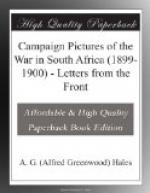I looked along our lines, and saw our soldiers standing patiently waiting for the curtain to fall. I was proud of them, and of the men who led them, for they had won without one cruel stroke. No single human life had wantonly been wasted, no dishonourable deed had smirched their arms, no smoking ruins cried aloud to God for retribution, no outraged women sobbed dry-eyed behind us, no starving children fled before the khaki wave; and in this last hour, an hour pregnant with humiliation and pain to our enemies, there was the steady manliness which spoke of the great dignity of a great nation. Out from the stillness a bugle spoke from the lines of the Leinsters; the Scottish bagpipes, far away down the hillside, took up the note with a shrill scream of triumph, like the challenge of an eagle in its eyrie. A rustle ran along the lines. We caught the hum of many voices, then the tramp of horses’ hoofs. A soldier slipped towards the spot where our country’s flag was furled and ready; a moment later the Union Jack spread out and hugged the breezes. Our foemen rode towards the flag between the lines of those whose hands had placed it there, and when they came abreast of it they dropped their rifles and their bandoliers, and with bent heads passed onwards.
Some were boys, so young that rifles looked unholy things in hands so childlike; others were old men, grey and grizzled, grim old tillers of the soil, who looked as hard as the rocky boulders against which they leant, many were in the pride of manhood; but old or young, grey beard or no beard, all of them seemed to realise that they were a beaten people. All day, and for many days, they came to us and laid their arms aside, until fully 4,000 men had owned themselves our prisoners. We gathered in the flocks and herds which had been held by them as army stores, and then we set to work to give the Free State peace and peaceful laws. Our next step was to march upon Harrismith, which was merely an armed promenade,




